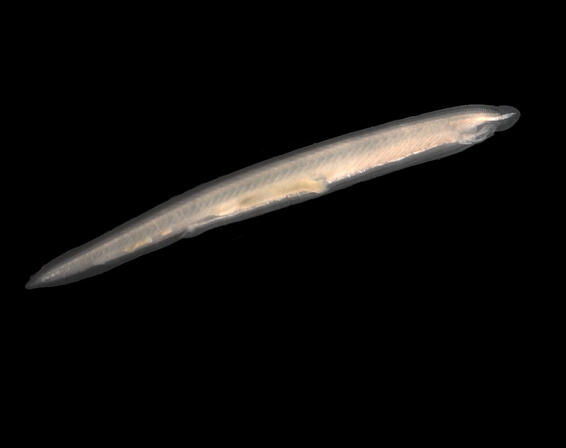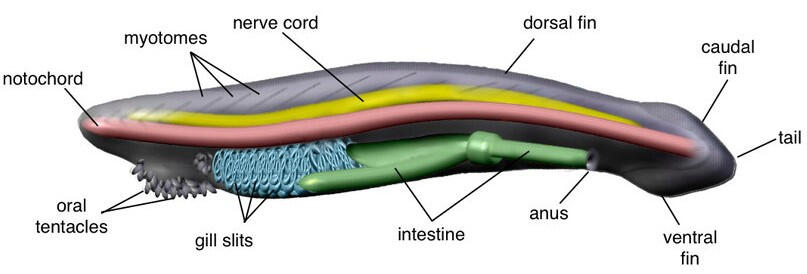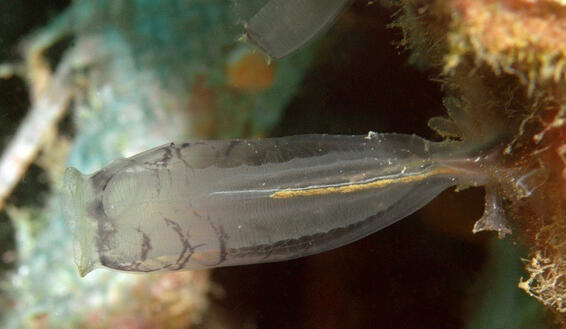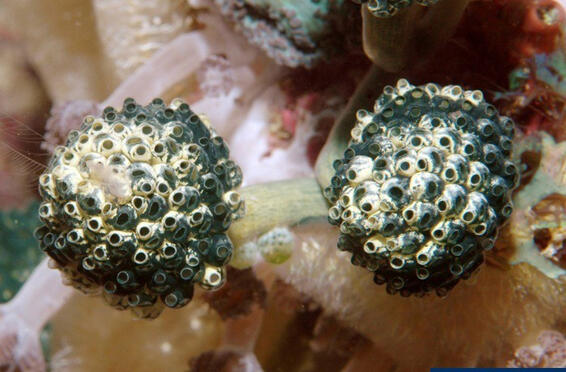Chordata
A phylum under kingdom Animalia, chordates are highlighted by the presence of four characteristics: notochord, a longitudinal, flexible rod located between the digestive tube and the nerve cord; post-anal tail, a muscular bony tail extending past the anus; dorsal hollow nerve cord, developed from an ectoderm rolling into a hollow neural tube; and pharyngeal slits or clefts, arches found along the outer surface of the pharynx.
Vertebrates make up majority of phylum Chordata, but not all chordates are vertebrates.
Basal Chordates

Branchiostoma lanceolatum
Comprised of the subphyla Cephalochordata and Urochordata (sometimes referred to as Tunicata), basal chordates are also known as the protochordates or invertebrate chordates. They have poor fossil records attributed to difficulty in interpreting what little discovered fossils there are due to their soft bodies.
Cephalochordata

As all chordates, cephalochordates (also called lancelets or amphioxi) possess the notochord, dorsal hollow nerve cord, pharyngeal slits, and post-anal tail. They have cilia that draw seawater into their mouth and a net of mucus that removes any tiny food particles that pass through it.
They are gonochoristic, having separate sexes, and undergo external fertilization, releasing the eggs and sperm into the water. Larvae are similar in structure to adults, although smaller and more asymmetrical, before metamorphosing into their adult form.
Due to the absence of a brain or a cranium, cephalochordates are sometimes referred to as acraniates. They do not have a heart.
The common ancestor of chordates are said to may have looked like lancelets.
Urochordata

Urochordata is the sister group of Vertebrata and are known as the closest relatives of vertebrates. Unlike cephalochordates, they are poor models for the last tunicate-vertebrate ancestor attributed to their rapid rates of evolution.
As all chordates, tunicates possess the notochord, dorsal hollow nerve cord, pharyngeal slits, and post-anal tail. These are more prominent in larvae, with their nervous system dissolving in adulthood. The term tunicate is derived from the tunic, the hard, leathery outer covering in which their bodies are embedded.
Most tunicates are hermaphroditic, allowing for both sexual and asexual reproduction. There exist both solitary and colonial tunicates, with solitary tunicates having a preference for sexual reproduction and colonies having a preference for asexual reproduction through budding.
They are marine filter-feeders with habitats ranging from shallow waters to the deep sea. Most are sessile or immobile. They possess two openings or siphons: the incurrent or oral siphon, through which water enters; and the excurrent or atrial siphon, through which water and other waste exits.
Examples of Basal Chordates

Rhopalaea crassa in Dinagat, Libjo, Philippines
Cephalochordata has only one class Leptocardii, comprised of around 30 species of lancelets. With three extant genera, the largest is Branchiostoma with some 11 species. Branchiostoma lanceolatum (shown here) is often used as a model organism in studying the evolution of the vertebrate.
Urochordata has some 3,000 species and is traditionally classified into three extant classes: Ascidiacea (ascidians or sea squirts), Thaliacea, and Appendicularia. Thaliacea contains the order Salpida, commonly known as salps.
Rhopalaea crassa (shown above) is a solitary sessile species of tunicate in class Ascidiacea, commonly found in crevices and between coral branches in the Indo-West Pacific. Its tunic ranges from yellow-green to orange-yellow.
Basal Chordates in the Philippines

Oxycorynia fascicularisa in Ticao, San Miguel, Philippines
There have been cephalochordates reported in the 1970s in Lucena Anchorage, Quezon, Philippines identified to be the species Branchiostoma belcheri and Epigonichthys cultellus. Little is known about cephalochordates in the Philippines.
Urochordates are more commonly found in Philippine waters than cephalochordates. These include species of the class Ascidiacea, more commonly known as sea squirts, and Thaliacea, commonly known as salps.
Sources
Abreo, N.A.S., Blatchley, D., & Superio, M.D. (2019). Stranded whale shark (Rhincodon typus) reveals vulnerability of filterfeeding elasmobranchs to marine litter in the Philippines. Marine Pollution Bulletin, 141, 79-83. doi:10.1016/j.marpolbul.2019.02.030
Actinopterygii - ray-finned fishes. (n.d). University College London. https://www.ucl.ac.uk/museums-static/obl4he/vertebratediversity/rayfinned_fishes.html
Alcala, A.C., Bucol, A.A., Diesmos, A.C., & Brown, R.M. (2012). Vulnerability of Philippine amphibians to climate change. Philippine Journal of Science, 141(1), 77-87.
Almendral, A. (2018, June 15). In the Philippines, dynamite fishing decimates entire ocean food chains. The New York Times. https://www.nytimes.com/2018/06/15/world/asia/philippines-dynamite-fishing-coral.html
Amsterdam, N. (2012). Carabao or Philippine water buffalo (Bubalus bubalis carabanesis) [Online image]. ZooChat. https://www.zoochat.com/community/media/carabao-or-philippine-water-buffalo-bubalus-bubalis-carabanesis.177249/
Ascher, J. (2014). Tanygnathus lucionensis, blue-naped parrot. Discover Life. https://www.discoverlife.org/mp/20p?see=I_JSA4364&res=640
Awruch, C.A. (2018). Chondrichthyes (Sharks, rays, skates and chimaeras). In M.K. Skinner (Ed.), Encylopedia of Reproduction (2nd ed., Vol. 6, pp. 554-559). Academic Press.
Benito-Gutiérrez, È. (2006). A gene catalogue of the amphioxus nervous system. International Journal of Biological Sciences, 2(3), 149-160. doi:10.7150/ijbs.2.149
Berkovitz, B. & Shellis, P. (2017). The teeth of non-mammalian vertebrates. Academic Press.
Bester, C. (n.d.). Callorhinchus milii. Florida Museum. https://www.floridamuseum.ufl.edu/discover-fish/species-profiles/callorhinchus-milii/
Bland, S.M. (n.d.). The man trying to save the Philippine tarsier from the black market. Vice. https://www.vice.com/en/article/pgkgvb/the-man-trying-to-save-the-filipino-tarsier-from-the-black-market
Brinker, A. (2017). Marbled salamander (Ambystoma opacum) [Online image]. iNaturalist. https://www.inaturalist.org/observations/8950086
Brown, R.M., Oliveros, C.H., Siler, C.D., Fernandez, J.B., Welton, L.J., Buenavente, P.A.C., Diesmos, M.L.L., & Diesmos, A.C. (2012). Amphibians and reptiles of Luzon Island (Philippines), VII: Herpetofauna of Ilocos Norte Province, Northern Cordillera Mountain Range. Check List, 8(3), 469–490. doi:10.15560/8.3.469
Brown, R.M., Siler, C.D., Oliveros, C.H., Welton, L.J., Rock, A., Swab, J., Van Weerd, M., van Beijnen, J., Jose, E., Rodriguez, D., Jose, E., & Diesmos, A.C. (2013). The amphibians and reptiles of Luzon Island, Philippines, VIII: the herpetofauna of Cagayan and Isabela Provinces, northern Sierra Madre Mountain Range. ZooKeys, 266, 1-120. doi:10.3897/zookeys.266.3982
Brusatte, S.L., O'Connor, J.K., & Jarvis, E.D. (2015). The origin and diversification of birds. Current Biology, 25(19), R888-R898. doi:10.1016/j.cub.2015.08.003
Capistrano, Z. (2021, January 15). PH eagle with gunshot wounds rescued in Sarangani. Manila Bulletin. https://mb.com.ph/2021/01/15/ph-eagle-with-gunshot-wounds-rescued-in-sarangani/
Carandang, N.C. (1978). The lancelets [Cephalochordata, Amphioxi] of Lucena Anchorage, Quezon, Philippines. Kalikasan: The Philippine Journal of Biology, 7(2), 177-186.
Clement, A.M., Gomon, M.F., & Bray, D.J. (2021). Australian lungfish, Neoceratodus forsteri (Krefft 1870). Fishes of Australia. https://fishesofaustralia.net.au/home/species/1988
Compagno, L.J.V., Last, P.R., Stevens, J.D., & Alava, M.N.R. (2005). Checklist of Philippine Chondrichthyes. CSIRO Marine Laboratories.
DeFlippo, J. & Beck, G. (2018). Tunicate immunology. Reference module in life sciences. Elsevier. https://doi.org/10.1016/B978-0-12-809633-8.90288-7
Donoghue, P.C.J. & Purnell, M.A. (2009). The evolutionary emergence of vertebrates from among their spineless relatives. Evolution: Education and Outreach, 2, 204-212. doi:10.1007/s12052-009-0134-3
Dowling, H.G. (2021, February 11). Reptile: Animal. Britannica. https://www.britannica.com/animal/reptile
Fasel, A. (2018). Andean flamingo - Phoenicoparrus andinus [Online image]. Oiseaux.net. https://www.oiseaux.net/photos/andre.fasel/andean.flamingo.3.html
Fidenci, P. & Maran, J. (2009). Illegal domestic trade of the Philippine forest turtle (Siebenrockiella leytensis) in the Philippines. TurtleLog, 3. doi:10.3854/tln.003.2009
First captive born Palawan forest turtle hatches at Katala Foundation, Inc. (2018, July 09). Turtle Conservancy. https://www.turtleconservancy.org/news/2018/7/first-captive-born-palawan-forest-turtle-hatches-at-katala-foundation-inc
Fletcher, R. (2021, January 08). Spotlight on farmed fish welfare in the Philippines. The Fish Site. https://thefishsite.com/articles/spotlight-on-farmed-fish-welfare-in-the-philippines
Forster, M.E. (2011). Hagfishes and lamprey | Hagfishes. In A.P. Farrell (Ed.), Encyclopedia of Fish Physiology (pp. 1771-1778). Academic Press.
Forsyth, I.A. (2002). Mammals. In J.W. Fuquay (Ed.), Encyclopedia of dairy sciences (2nd ed., pp. 320-327). Academic Press.
Francisco, M.A. (2019, July 04). FlipFact (July 4, 2019): As faithful as the Philippine eagle. FlipScience. https://www.flipscience.ph/flipfacts/flipfact-july-4-2019-as-faithful-as-the-philippine-eagle/
Fudge, D.S., Levy, N., Chiu, S., & Gosline, J.M. (2005). Composition, morphology, and mechanics of hagfish slime. The Journal of Experimental Biology, 208, 4613-4625. doi:10.1242/jeb.01963
Gasparini, F. & Ballarin, L. (2018). Reproduction in tunicates. In M.K. Skimmer (Ed.), Encyclopedia of reproduction (2nd ed., pp. 546-553). https://doi.org/10.1016/B978-0-12-809633-8.20601-8
Gibson, M. & Newsham, P. (2018). Food science and the culinary arts. Academic Press.
Ghiselin, M.T. (n.d.). Tunicate: Chordate subphylum. Britannica. https://www.britannica.com/animal/tunicate
Ghiselin, M.T. (n.d.). Cephalochordate: Chordate subphylum. Britannica. https://www.britannica.com/animal/cephalochordate
Gonzáles, A. & Northcutt, R.G. (2011). Functional morphology of the brains of sarcopterygian fishes: Lungfishes and Latimeria. In A.P. Farrell (Ed.), Encyclopedia of fish physiology (pp. 46-55). Academic Press.
Gregory, T.R. (2005). Genome size evolution in animals. In T.R. Gregory (Ed.), The evolution of the genome (pp. 3-87). Academic Press.
Halliday, T. (2013). Endangered amphibians. In S.A. Levin (Ed.), Encyclopedia of biodiversity (2nd ed., pp. 164-168). Academic Press.
Halliday, T. (2013). Endangered reptiles. In S.A. Levin (Ed.), Encyclopedia of biodiversity (2nd ed., pp. 216-218). Academic Press.
Heinicke, M.P., Naylor, G.J.P., & Hedges, S.B. (2009). Cartilaginous fishes (Chondrichthyes). In S.B. Hedges & S. Kumar (Eds.), The timetree of life (pp. 320-327). Oxford University Press.
Helfman, G.S. (2013). Fishes, biodiversity of. In S.A. Levin (Ed.), Encyclopedia of Biodiversity (2nd ed., pp. 456-476). Academic Press.
Hellingman, R.G. (n.d.). Philippine tarsier (Carlito syrichta) [Online image]. Bohol.ph. https://www.bohol.ph/picture1791.html
Hobern, D. (n.d.). Western gray kangaroo [Online image]. Animalia. https://animalia.bio/western-grey-kangaroo
Holland, L.Z. (2016). Tunicates. Current Biology, 26(4), R146-R152. doi:10.1016/j.cub.2015.12.024
Hughes, L.C., Orti, G., Huang, Y., Sun, Y., Baldwin, C.C., Thompson, A.W., Arcila, D., Betancur-R., R., Li, C., Becker, L., Bellora, N., Zhao, X., Li, X., Wang, M., Fang, C., Xie, B., Zhuo, Z., Huang, H., Chen, S. ... Shi, Q. (2018). Comprehensive phylogeny of ray-finned fishes (Actinopterygii) based on transcriptomic and genomic data. Proceedings of the National Academy of Sciences, 115(24). doi:10.1073/pnas.1719358115
Inoue, J.G., Miya, M., Lam, K., Tay, B.-H., Danks, J.A., Bell, J., Walker, T.I., & Venkatesh, B. (2010). Evolutionary origin and phylogeny of the modern holocephalans (Chondrichthyes: Chimaeriformes): A mitogenomic perspective. Molecular Biology and Evolution, 27(11), 2576-2586. doi:10.1093/molbev/msq147
Jamaican iguana Cyclura collei. (n.d.). Zoo New England. https://www.zoonewengland.org/stone-zoo/our-animals/reptiles-amphibians/jamaican-iguana/
Jude, E., Johanson, Z., Kearsley, A., & Friedman, M. (2014). Early evolution of the lungfish pectoral-fin endoskeleton: evidence from the Middle Devonian (Givetian) Pentlandia macroptera. Frontiers in Earth Science, 2(18). doi:10.3389/feart.2014.00018
Kubicek, C. (n.d.). Tarsius syrichta: Philippine tarsier. Animal Diversity Web. https://animaldiversity.org/accounts/Tarsiussyrichta/
Lamarca, N.S.J. (2017). Fisheries country profile: Philippines. Southeast Asian Fisheries Development Center. http://www.seafdec.org/fisheries-country-profile-philippines/
Maina, J.N. (1987). The morphology of the lung of the African lungfish, Protopterus aethiopicus: A scanning electron-microscopic study. Cell and Tissue Research, 250, 191-196. doi:10.1007/bf00214671
Mascariñas, E.M. (2018, June 04). PH sailfin lizards in Misamis Oriental: An unusual case of a community lizard. ABS-CBN News. https://news.abs-cbn.com/focus/06/02/18/ph-sailfin-lizards-in-misamis-oriental-an-unusual-case-of-a-community-lizard
Mateo, J. (2020, January 24). Tawilis extinction feared; breast milk, other forms of aid continue for Taal evacuees. One News. https://www.onenews.ph/tawilis-extinction-feared-breast-milk-other-forms-of-aid-continue-for-taal-evacuees
McGrouther, M. (2020, December 21). Australian lungfish. Australian Museum. https://australian.museum/learn/animals/fishes/australian-lungfish-neoceratodus-forsteri-krefft-1870/
Meniano, S. (2018, November 27). DA to tap Samar youth in farm modernization. Philippine News Agency. https://www.pna.gov.ph/articles/1055058
Meyers, J. (n.d.). Phoenicoparrus andinus: Andean flamingo. Animal Diversity Web. https://animaldiversity.org/accounts/Phoenicoparrusandinus/
Miller, D. (n.d.). Macropus fuliginosus: western gray kangaroo. Animal Diversity Web. https://animaldiversity.org/accounts/Macropusfuliginosus/
Mincarone, M.M. & Fernholm, B. (2010). Review of the Australian hagfishes with description of two new species of Eptatretus (Myxinidae). Journal of Fish Biology, 77, 779-801. doi:10.1111/j.1095-8649.2010.02661.x
Mongabay.com. (2018, January 19). Facebook being used for illegal reptile trade in the Philippines. Mongabay. https://news.mongabay.com/2018/01/facebook-being-used-for-illegal-reptile-trade-in-the-philippines/
Monniot, F. & Monniot, C. (2001). Ascidians from the tropical western Pacific. Zoosystema, 23(2), 201-383.
Niigata City Aquarium. (n.d.). いきもの情報: カワヤツメ [Animal information: Arctic lamprey]. https://www.marinepia.or.jp/news/2021011814248.html
Ocean sunfish. (n.d.). National Geographic. https://www.nationalgeographic.com/animals/fish/facts/ocean-sunfish
Panela, S. (2015, August 20). Critically endangered Philippine eagle found shot dead. Earth Journalism Network. https://earthjournalism.net/stories/critically-endangered-philippine-eagle-found-shot-dead
Pangilinan, L. (2014, October 03). In focus: 9 facts you may not know about Philippine national symbols. National Commission for Culture and the Arts. https://ncca.gov.ph/about-culture-and-arts/in-focus/9-facts-you-may-not-know-about-philippine-national-symbols/
Penketh, L., Schleimer, A., Labaja, J., Snow, S., Ponzo, A., & Araujo, G. (2020). Scarring patterns of whale sharks, Rhincodon typus, at a provisioning site in the Philippines. Aquatic Conservation: Marine and Freshwater Ecosystems, 1-13. doi:10.1002/aqc.3437
Perini, F.A. (2016). Mammals, origin of. In R.M. Kliman (Ed.), Encyclopedia of evolutionary biology (pp. 430-439). Academic Press.
Philippine Eagle Pithecophaga jefferyi. (n.d.). EDGE of Existence. http://www.edgeofexistence.org/species/philippine-eagle/
Pombal, M.A. & Megías, M. (2017). The nervous system of jawless vertebrates. In J.H. Kaas (Ed.), Evolution of nervous systems (2nd ed., Vol. 1, pp. 37-57). Academic Press.
Poppe, G. (2006). Diazonidae - Rhopalaea crassa [Online image]. Poppe Images. https://www.poppe-images.com/?t=17&photoid=927121
Poppe, G. (2006). Polycitoridae - Oxycorynia fascicularis [Online image]. Poppe Images. https://www.poppe-images.com/?t=17&photoid=925295
Ramel, G. (n.d.). Cephalochotdata: Subphylum of the ancient lancelets. Earth Life. https://www.earthlife.net/inverts/cephalochordata.html
Rand, A.L. (n.d.). Bird: Animal. Britannica. https://www.britannica.com/animal/bird-animal
Razy-Krajka, F. & Stolfi, A. (2019). Regulation and evolution of muscle development in tunicates. EvoDevo, 10(13). doi:10.1186/s13227-019-0125-6
Řeháková, M. (2019). Successful breeding attempt of a pair of Philippine tarsier (Tarsius syrichta) in a conservation center in Bilar, Bohol, Philippines and recommendations for tarsier husbandry. Zoo Biology, 1-6. doi:10.1002/zoo.21501
Rogers, G. (n.d.). Ambystoma opacum marbled salamander. Animal Diversity Web. https://animaldiversity.org/accounts/Ambystoma_opacum/
Sanguila, M., Cobb, K., Siler, C., Diesmos, A., Alcala, A., & Brown, R. (2016). The amphibians and reptiles of Mindanao Island, southern Philippines, II: the herpetofauna of northeast Mindanao and adjacent islands. Zookeys, 624, 1-132. doi:10.3897/zookeys.624.9814
Sea lamprey (Petromyzon marinus) displaying its prominent mouthparts [Online image]. Britannica. https://www.britannica.com/animal/sea-lamprey
Schlosser, G. (2015). Vertebrate cranial placodes as evolutionary innovations — the ancestor's tale. In P.A. Trainor (Ed.), Current topics in developmental biology (Vol. 111, pp. 235-300). doi:10.1016/bs.ctdb.2014.11.008
Shark anatomy. (n.d.). Shark Trust. https://www.sharktrust.org/shark-anatomy
Shimeld, S.M. & Donoghue, P.C.J. (2012). Evolutionary crossroads in developmental biology: Cyclostomes (lamprey and hagfish). Development, 139, 2091-2099. doi:10.1242/dev.074716
Simmons, A.M. & Alexander, E.E. (2014). Development of the statoacoustic system of amphibians. In R. Romand & I. Varela-Nieto (Eds.), Development of auditory and vestibular systems (4th ed., pp. 369-412). Academic Press.
Smithsonian. (n.d.). Coelacanth. Ocean: Find Your Blue. https://ocean.si.edu/ocean-life/fish/coelacanth
Snow, S. (2018, January 05). Scientists film the first ever live encounter of the rare and endangered ornate eagle ray in the Philippines. Large Marine Vertebrates Research Institute Philippines. https://www.lamave.org/news/2018/1/29/press-release-2
Snow, S. (2018, December 11). A new study reveals the impacts of whale shark mass tourism on the coral reefs in Oslob, Cebu, Philippines. Large Marine Vertebrates Research Institute Philippines. https://www.lamave.org/news/scientific-study-coral-reef-degradation-oslob
Song, Y.S. & Kim, J.-K. (2020). A new species of hagfish, Eptatretus wandoensis sp. nov. (Agnatha, Myxinidae), from the southwestern Sea of Korea. ZooKeys, 926, 81-94. doi:10.3897/zookeys.926.48745
Song, Y.S. & Kim, J.-K. (2020). Molecular phylogeny and classification of the family Myxinidae (Cyclostomata: Myxiniformes) using the supermatrix method. Journal of Asia-Pacific Biodiversity, 13, 533-538. doi:10.1016/j.japb.2020.09.006
Stedman, N.L. & Garner, M.M. (2018). Chondrichthyes. In K.A. Terio, D. McAloose, & J. St. Leger (Eds.), Pathology of wildlife and zoo animals (pp. 1003-1018). Academic Press.
Synopsis of Philippine mammals. (n.d.). Field Museum. https://www.fieldmuseum.org/synopsis-philippine-mammals
Theodosiou, M., Colin, A., Schulz, J., Laudet, V., Peyrieras, N., Nicolas, J.-F., Schubert, M., & Hirsinger, E. (2011). Amphioxus spawning behavior in an artificial seawater facility. Journal of Experimental Zoology, 316, 263-275. doi:10.1002/jez.b.21397
Walford, L.A. (n.d.). Chondrichthyan: Fish class. Britannica. https://www.britannica.com/animal/chondrichthian
Whitfield Gibbons, J. & Luhring, T.M. (2009). Reptiles. In G.E. Likens (Ed.), Encyclopedia of inland waters (pp. 497-505). Academic Press.
Woodley, S.K. (2018). Overview of amphibian reproduction. In M.K. Skinner (Ed.), Encyclopedia of reproduction (2nd ed., Vol. 6, pp. 567-572). Academic Press.